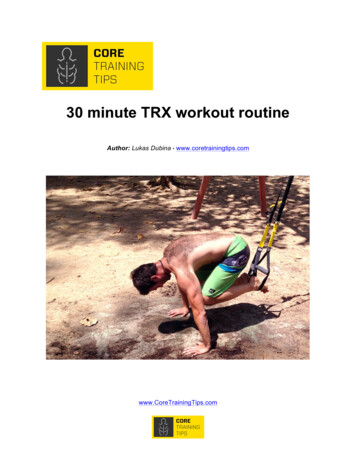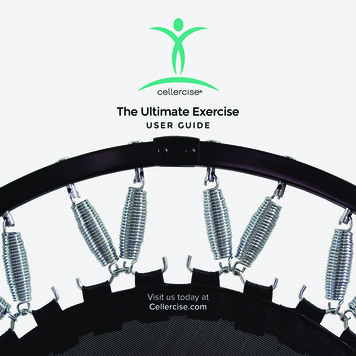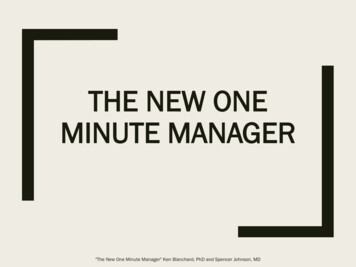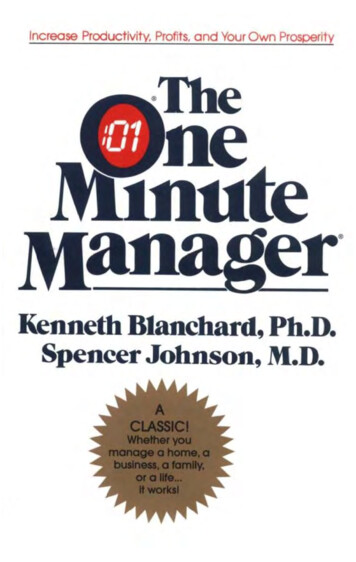
Transcription
The 20 Minute Guide toUsing MS Access 2007This is a quick start guide to get you up and running withMS Access 2007. It takes you through some of the newfeatures of the product as well as how to create a databasefrom scratch.Paul Barnett6/15/2009
If you would like to take your learning further and delve deeper into MS Access then get onboard my latest online course. There are over 150 videos and over 75 PDF files. You alsoget to use an interactive forum where I answer questions on anything course related you arenot sure of.Do you want to get a Microsoft Access tutorial series that's jampacked with hints and tips on how to make the most of the powerfulaccess tools and applications in this useful software? Well now youcan! Learning Microsoft Access is now simpler than ever.Begin today and get your data in order l/ContentsWhat is a database? . 3Access 2007. 3Create a brand new database . 4The Navigation Pane . 9Create a form . 12Create a query . 14Create a report. 16Summary . 19About the author . 192
What is a database?A database can best be described as a way of storing large amounts of information. Thedata can be retrieved and we can even ask questions of the data and get answers. Forexample I may want to know how many customers sold widgets in the city of London for themonth of July. Access is a PC desktop database and it is possible to create some powerfulsystems.Access 2007Access 2007 is a major overhaul in terms of the interface. The menus are now replaced bythe Ribbon. At first it takes some getting used to if you have come from a previous version ofMS Access.Introducing the RibbonThe Ribbon contains the essential commands necessary for creating and manipulating yourdatabase.The Ribbon is divided into groups and each group contains a series of commands. Forexample the forms group contains form related commands. The Ribbon changes the viewand commands depending on the object you are using. If you are in open table mode theRibbon will display a set of commands related to this mode.The Quick Access ToolbarThis is another new feature and is a small bar that contains commands you use often suchas save, undo and redo.3
Create a brand new databaseLoad up MS Access 2007 and the opening screen will appear.Click the option ‘New Blank Database’4
You can also click the MS Office button at the top left.Then select the option called ‘New’.At the bottom right of the screen enter a name for the new database and then click thecreate button.MS Access will now open at a screen for you to enter some data.5
You could at this point double click the ‘Add New Field’ heading and then type in a columnname.Then click in the actual cell and type in some data.Alternatively you can go into table design view and gain more control over the table creation.At the top left click the ‘View’ button and select the ‘Design View’ option.This will take you into design view of the table.Access uses what are known as tables to store the data. No, this has nothing to do with adining table – a table in Access is a container with columns such as name, address etc.Tables are the most important object in MS Access and are a useful starting point for anynew database.Access will ask you to save the table and to enter a name for it. Enter a name and click theok button.6
Now you are in table design view. The two columns to be concerned with are ‘Field Name’and also ‘Data Type’. Access has already created a column called ‘ID’. This is fine andshould be left here.Click on the second line and enter a column name. I will be entering ‘FirstName’. You canadd a space between the words, but there are good reasons not to.Tab along to the ‘Data Type’ column and click the down arrow.You will then see a list of possible data types to use for the ‘FirstName’ column.Can you guess which one to use? Well, I am not entering a price so I don’t want to use anumeric or number data type. In this case for a ‘FirstName’ the most suitable data typewould be ‘Text’.7
At the bottom of the screen you can set how many characters should be entered for this‘FirstName’ column. I set it to 20.Enter some more columns and choose the appropriate data type and column size.When you are done click the save button.Right click the table tab and select the ‘Close’ option.8
The Navigation PaneThe navigation pane replaces the database window used in previous versions of MS Access.It holds all objects in the database such as tables, forms, queries, reports, macros andprogram code modules.The navigation pane is tucked away at the left hand side.Click the double arrow, known as the ‘Shutter bar open/close button’ to expand or collapsethe pane.9
The table I just created is held there.Click the small down arrow to select the object you wish to view.10
Right click the table and select the ‘Open’ option.Click in the ‘FirstName’ column and enter some data.Tab along to each field and enter more information.Click on a new line to enter a new record.Note: When you enter data into a table or even a form, MS Access saves it automatically.11
Now close the table.Right click the table tab and select the close option.Create a formForms provide a user friendly visual way to enter and present data.Forms take their data from a table or a query.Let’s create a brand new form based on the table we just created.Click the ‘Create’ tab on the Ribbon.At the navigation pane, click the table to base the form on. The table name will highlightwhen selected.At the Ribbon in the forms section, click the ‘Form’ option.12
MS Access creates a quick form.The form contains the columns and data you created in the table.At the bottom of the form are the navigation buttons.Clicking the arrows will move through each record. To create a new blank record, click thearrow with an orange symbol next to it.You can then enter new information into the form fields.Click the save button on the quick access toolbar and give the form a name.13
Create a queryA query is used to ask questions and get answers from the data.Let’s go ahead and create a brand new query.Click the create tab on the Ribbon.At the section called ‘Other’ select the option called ‘Query Design’.Select the table to use in the query and then click the ‘Add’ button.14
Double click the column names to use in the queryEach column will drop into the query design grid.In this example I am going to extract all customers in the state of ‘CA’.I do this by entering ‘CA’ on the criteria line under the state column.Now run the query by clicking the ‘Run’ button on the Ribbon.15
I get the following results returned.3 records have been returned for the state of ‘CA’.Removing the criteria from the query grid would return all records.Create a reportReports allow you to show data in a printable format. You can base a report on a table or aquery. So let’s go ahead and create a very quick basic report in MS Access 2007.Click on a table in the navigation pane.Here I click on the ‘Customers’ table and it becomes highlighted.At the Ribbon make sure the ‘Create’ tab is selected.16
At the reports section click on the item called ’Report Wizard’.Select the table or query to base the report on.In the left box double click the field you wish to show on the report. The item will move to thebox on the right. You can also use the arrow keys to move fields between the two boxes.Click the ‘Finish’ button.17
The report will show in print preview mode.To print the report, click the ‘Print’ button.18
SummaryI hope this has given you an overview of some of the features of MS Access 2007. If youhave come from a previous version it might take some getting used to. However, stick with itand you will uncover just how powerful it can be.About the authorPaul Barnett is an Access developer from London, UK.He has been developing software for 15 years. Hisproducts and training have helped hundreds world over,including companies such as IBM and MCI WorldCom.He believes in the power of simplicity and that the systemshould only do what the user asks for. It should notinclude features that were never asked for.“I believe software should empower the user so that theyare able to go in and change it whenever they like. Ialways look at it from the user points of view and not theprogrammers. Give them what they want. Keep it simpleyet powerful.”Email him at: sellwindowsmedia@yahoo.comDo you want to get a Microsoft Access tutorial series that's jampacked with hints and tips on how to make the most of the powerfulaccess tools and applications in this useful software? Well now youcan! Learning Microsoft Access is now simpler than ever.Begin today and get your data in order l/For software, ebooks and training on MS Access please visit the websitehttp://www.access-databases.com19
Jun 15, 2009 · Access 2007 is a major overhaul in terms of the interface. The menus are now replaced by the Ribbon. At first it takes some getting used to if you have come from a previous version of MS Access. Introducing the Ribbon The Ribbon contains the essential commands necessary for creating and manipulating yourFile Size: 936KB











